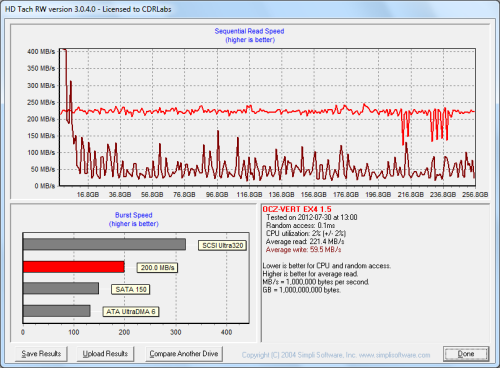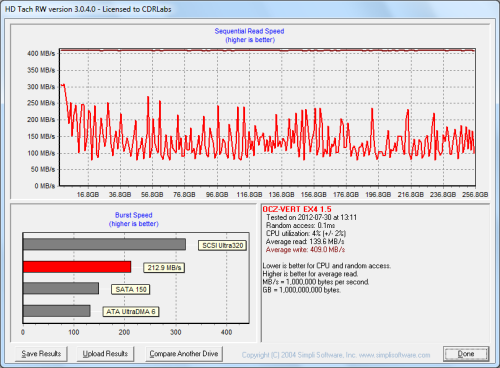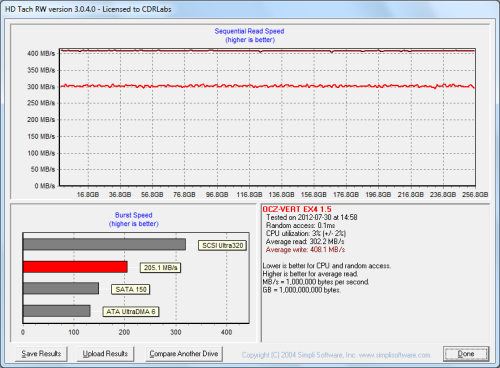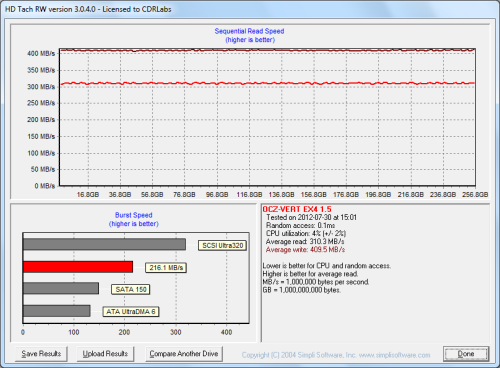TRIM Performance:
While SSD's offer many benefits, there are some downsides to using flash memory. One of the biggest issues people run into is performance degradation. Over time, an SSD will run out of fresh blocks and will have to write over data the file system has marked as deleted. This procedure is very complicated and can slow an SSD's write speeds considerably.
To fix this problem, most manufacturers have added TRIM support to their SSDs. The TRIM command allows an operating system, such as Windows 7, to tell an SSD which data blocks are no longer in use. Using this information, the drive pro-actively erases these blocks and adds them to the free block pool.

The Vertex 4 also uses a number of other flash management techniques including background garbage collection, dynamic and static wear-leveling and advanced flash defect management. Where flash defect management and wear leveling optimize the way data is written on the drive, garbage collection maintains "like new" performance by reorganizing data to maximize the number of free cells.
To test the Vertex 4's TRIM and garbage collection functions, I first put the drive in a "dirty" state. I used Iometer to fill the entire drive and then ran a random write test for 30 minutes. Looking at the screenshot below, you can see that the Vertex 4's average read and write speeds dropped to 221.4 MB/s and 59.5 MB/s, respectively.

OCZ Vertex 4 - Dirty
The Vertex 4's average write speed bounced back up to 409 MB/s within a matter of minutes. However, its average read speed dropped down to 139.6 MB/s while it was recovering.

OCZ Vertex 4 - Recovering
I let the computer sit for a few hours and then reran the test. Looking at the screenshot below, you can see that the Vertex 4's average read speed had increased to 302.2 MB/s.

OCZ Vertex 4 - After TRIM
Lastly, I used OCZ's Toolbox utility to perform a secure erase on the Vertex 4. With the drive wiped clean, it had average read and write speeds of 310.3 MB/s and 409.5 MB/s, respectively.

OCZ Vertex 4 - Wiped
Final Thoughts:
OCZ had a very good run with SandForce but, if the Vertex 4 is any indication, the company's future is with Indilinx. Powered by the Indilinx infused Everest 2 controller, the Vertex 4 combines synchronous MLC NAND with a massive cache to deliver some of the best all around performance we've seen. With the v1.5 firmware, the drive was able to read at speeds as high as 561 MB/s and write at speeds in excess of 480 MB/s. The Vertex 4 also edged out the SandForce-based SSDs for the top spot in our 4K random write tests, producing more than 82,000 IOPS. Best of all, it performed equally well with compressible and incompressible data and was able to sustain these speeds, even after intensive use.
The Vertex 4 is available now in 64GB, 128GB, 256GB and 512GB capacities. Prices on Amazon currently range from $74 up to $545, with the 256GB version reviewed here going for about $210. At less than $1/GB this is a very good price, especially when you consider that the 240GB Vertex 3 still goes for around $200 and the 256GB Plextor M5S sells for nearly $250.

Highs:
- Available in 64GB, 128GB, 256GB and 512GB capacities
- Good sequential read and write speeds
- Excellent random read and write performance
- Performs equally well with compressible and incompressible data
- Indilinx Ndurance 2.0 technology extends life of NAND flash
- SATA 6Gb/s interface
- Synchronous NAND flash
- Large DRAM cache
- Supports TRIM, dynamic and static wear-leveling and background garbage collection
- Automatic 256-bit AES encryption
- Includes a 2.5" to 3.5" adapter bracket
- 5 year warranty
- Reasonably priced
Lows:
- Requires firmware updates for best performance

